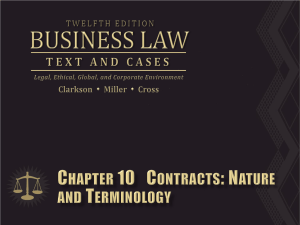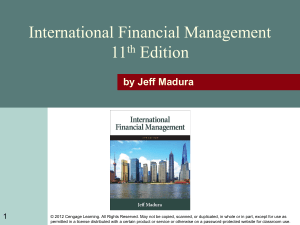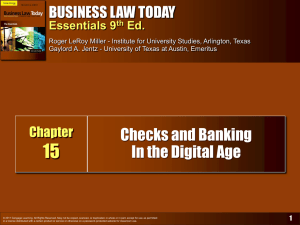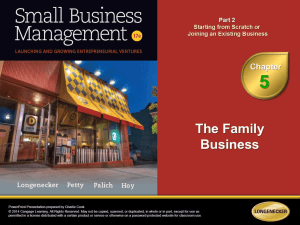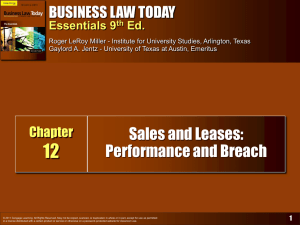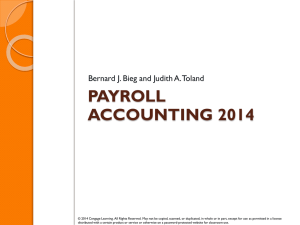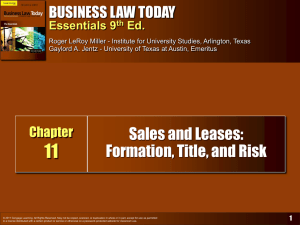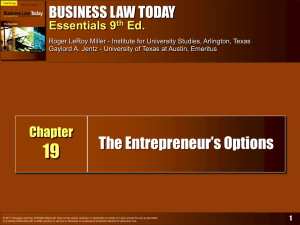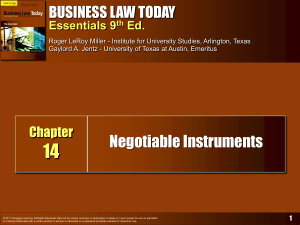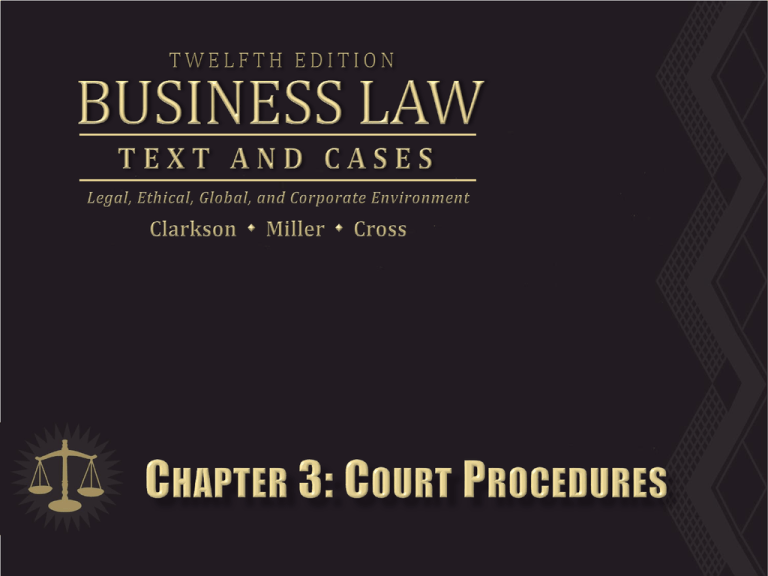
American and English court systems
follow the adversarial system of
justice.
Each client is represented by an
attorney although a client is allowed
to represent herself (called “prose”).
© 2012 Cengage Learning. All Rights Reserved. May not be copied, scanned, or duplicated, in whole or in part, except for use as permitted in a
license distributed with a certain product or service or otherwise on a password-protected website for classroom use.
2
Trials involve “due process” which
requires adequate notice and a fair
and impartial hearing.
For example, all civil trials in federal
court are governed by the Federal
Rules of Civil Procedure (FRCP).
© 2012 Cengage Learning. All Rights Reserved. May not be copied, scanned, or duplicated, in whole or in part, except for use as permitted in a
license distributed with a certain product or service or otherwise on a password-protected website for classroom use.
3
Pretrial.
Trial.
Posttrial.
© 2012 Cengage Learning. All Rights Reserved. May not be copied, scanned, or duplicated, in whole or in part, except for use as permitted in a
license distributed with a certain product or service or otherwise on a password-protected website for classroom use.
4
Antonio
Carvello
Jill Kirby
(New York)
(New Jersey)
Carvello
hits Kirby
in New
York City
© 2012 Cengage Learning. All Rights Reserved. May not be copied, scanned, or duplicated, in whole or in part, except for use as permitted in a
license distributed with a certain product or service or otherwise on a password-protected website for classroom use.
5
© 2012 Cengage Learning. All Rights Reserved. May not be copied, scanned, or duplicated, in whole or in part, except for use as permitted in a
license distributed with a certain product or service or otherwise on a password-protected website for classroom use.
6
Generally, the first step in litigation
is contacting any attorney to seek
qualified legal advice.
Types of Attorneys’ Fees (hourly vs.
contingent fee).
Settlement Considerations.
© 2012 Cengage Learning. All Rights Reserved. May not be copied, scanned, or duplicated, in whole or in part, except for use as permitted in a
license distributed with a certain product or service or otherwise on a password-protected website for classroom use.
7
Pleadings.
Discovery.
Conference
Jury Selection.
© 2012 Cengage Learning. All Rights Reserved. May not be copied, scanned, or duplicated, in whole or in part, except for use as permitted in a
license distributed with a certain product or service or otherwise on a password-protected website for classroom use.
8
1st
2nd
3rd
4th
Pleadings // Discovery // Conference // Jury
© 2012 Cengage Learning. All Rights Reserved. May not be copied, scanned, or duplicated, in whole or in part, except for use as permitted in a
license distributed with a certain product or service or otherwise on a password-protected website for classroom use.
9
Plaintiff’s
Complaint.
Court acquires
jurisdiction over
subject matter
and Plaintiff.
Facts: What
happened.
Prayer: Court
relief.
© 2012 Cengage Learning. All Rights Reserved. May not be copied, scanned, or duplicated, in whole or in part, except for use as permitted in a
license distributed with a certain product or service or otherwise on a password-protected website for classroom use.
10
Plaintiff serves
Defendant with
Complaint and
Summons.
Default
Judgment for
Plaintiff if
Defendant does
not Answer.
© 2012 Cengage Learning. All Rights Reserved. May not be copied, scanned, or duplicated, in whole or in part, except for use as permitted in a
license distributed with a certain product or service or otherwise on a password-protected website for classroom use.
11
Usually by Sheriff or private process
server. Copy of Complaint and
Summons personally delivered.
If Defendant cannot be reached,
“Notice by Publication” is allowed in
local newspaper of record.
© 2012 Cengage Learning. All Rights Reserved. May not be copied, scanned, or duplicated, in whole or in part, except for use as permitted in a
license distributed with a certain product or service or otherwise on a password-protected website for classroom use.
12
Corporate Defendants served via
Registered Agent. If the Defendant is
out-of-state, Court can acquire
jurisdiction by “long-arm” statutes.
CASE 3.1
Cruz v. Fagor America, Inc.
(2007). Did the Plaintiff properly serve an
out-of-state corporation?
Waiver of Formal Service of Process.
© 2012 Cengage Learning. All Rights Reserved. May not be copied, scanned, or duplicated, in whole or in part, except for use as permitted in a
license distributed with a certain product or service or otherwise on a password-protected website for classroom use.
13
The Answer is the Defendant’s
response to the allegations stated in
the Plaintiff’s Complaint.
In the Answer, the Defendant must
specifically admit or deny each
allegation in the Complaint.
© 2012 Cengage Learning. All Rights Reserved. May not be copied, scanned, or duplicated, in whole or in part, except for use as permitted in a
license distributed with a certain product or service or otherwise on a password-protected website for classroom use.
14
Defendant’s Answer:
Makes General Denial.
May move for Change of Venue.
May allege Affirmative Defenses.
May assert Counterclaims against
Plaintiff.
© 2012 Cengage Learning. All Rights Reserved. May not be copied, scanned, or duplicated, in whole or in part, except for use as permitted in a
license distributed with a certain product or service or otherwise on a password-protected website for classroom use.
15
Carvello could assert that Kirby was
driving negligently at the time of
the accident.
Comparative Negligence vs. Contributory
Negligence.
Burden of proof is on Carvello to
show Kirby was negligent.
© 2012 Cengage Learning. All Rights Reserved. May not be copied, scanned, or duplicated, in whole or in part, except for use as permitted in a
license distributed with a certain product or service or otherwise on a password-protected website for classroom use.
16
Counterclaim is a lawsuit filed by
Carvello against Kirby, alleging Kirby
injured or caused damages to
Carvello.
Kirby
Carvello
(Plaintiff)
(Defendant)
© 2012 Cengage Learning. All Rights Reserved. May not be copied, scanned, or duplicated, in whole or in part, except for use as permitted in a
license distributed with a certain product or service or otherwise on a password-protected website for classroom use.
17
Many lawsuits never go to trial.
Perhaps there is a settlement.
Perhaps the case was dismissed.
Parties often file “Pre-Trial Motions”
asking the Court to do something.
Motions must be filed and served on the
other party.
© 2012 Cengage Learning. All Rights Reserved. May not be copied, scanned, or duplicated, in whole or in part, except for use as permitted in a
license distributed with a certain product or service or otherwise on a password-protected website for classroom use.
18
Motion to Dismiss.
Either party (normally defendant) can
ask the court to dismiss the case if the
pleadings fail to show a legal claim.
Motion for Judgment on the
Pleadings.
© 2012 Cengage Learning. All Rights Reserved. May not be copied, scanned, or duplicated, in whole or in part, except for use as permitted in a
license distributed with a certain product or service or otherwise on a password-protected website for classroom use.
19
Motion For Summary Judgment.
Asks a court to grant a judgment for
moving party without a trial.
Facts are viewed in the light most
favorable to the other party.
Admissible evidence is submitted:
affidavits, documents, contracts, emails.
© 2012 Cengage Learning. All Rights Reserved. May not be copied, scanned, or duplicated, in whole or in part, except for use as permitted in a
license distributed with a certain product or service or otherwise on a password-protected website for classroom use.
20
© 2012 Cengage Learning. All Rights Reserved. May not be copied, scanned, or duplicated, in whole or in part, except for use as permitted in a
license distributed with a certain product or service or otherwise on a password-protected website for classroom use.
21
1st
2nd
3rd
4th
Pleadings // Discovery // Conference // Jury
© 2012 Cengage Learning. All Rights Reserved. May not be copied, scanned, or duplicated, in whole or in part, except for use as permitted in a
license distributed with a certain product or service or otherwise on a password-protected website for classroom use.
22
Discovery is the process by which
parties obtain information from the
opposing party prior to trial.
Kirby and Carvello will want to know
about each other to prevent
‘surprises’ at trial.
© 2012 Cengage Learning. All Rights Reserved. May not be copied, scanned, or duplicated, in whole or in part, except for use as permitted in a
license distributed with a certain product or service or otherwise on a password-protected website for classroom use.
23
Case 3.2 Blankenship v. Collier
(2010). What happens when Plaintiff
fails to identify witnesses?
Discovery Rules.
Depositions: sworn testimony
recorded and transcribed by court
official (court reporter).
© 2012 Cengage Learning. All Rights Reserved. May not be copied, scanned, or duplicated, in whole or in part, except for use as permitted in a
license distributed with a certain product or service or otherwise on a password-protected website for classroom use.
24
Interrogatories: written questions
and answers under oath.
Requests for Admissions: admission
is considered a “fact” for trial.
Requests for Documents, Objects,
and Entry Upon Land.
Carvello could request Kirby’s car repair
bills.
© 2012 Cengage Learning. All Rights Reserved. May not be copied, scanned, or duplicated, in whole or in part, except for use as permitted in a
license distributed with a certain product or service or otherwise on a password-protected website for classroom use.
25
Requests for Examination.
Carvello and Kirby could request
examinations of the cars, medical
records.
Electronic Discovery (E-Evidence).
FRCP deals specifically with
preservation, retrieval, and production
of electronic data.
© 2012 Cengage Learning. All Rights Reserved. May not be copied, scanned, or duplicated, in whole or in part, except for use as permitted in a
license distributed with a certain product or service or otherwise on a password-protected website for classroom use.
26
1st
2nd
3rd
4th
Pleadings // Discovery // Conference // Jury
© 2012 Cengage Learning. All Rights Reserved. May not be copied, scanned, or duplicated, in whole or in part, except for use as permitted in a
license distributed with a certain product or service or otherwise on a password-protected website for classroom use.
27
After discovery is completed meet
with trial judge.
Explore possibility of settlement, or
identify issues that are in dispute
for jury to consider.
© 2012 Cengage Learning. All Rights Reserved. May not be copied, scanned, or duplicated, in whole or in part, except for use as permitted in a
license distributed with a certain product or service or otherwise on a password-protected website for classroom use.
28
1st
2nd
3rd
4th
Pleadings // Discovery // Conference // Jury
© 2012 Cengage Learning. All Rights Reserved. May not be copied, scanned, or duplicated, in whole or in part, except for use as permitted in a
license distributed with a certain product or service or otherwise on a password-protected website for classroom use.
29
Right to Jury Trial is guaranteed by
Seventh Amendment to U.S.
Constitution.
Jury Selection.
Voir Dire.
Jurors can be dismissed peremptorily (no
reason or for cause (bias).
© 2012 Cengage Learning. All Rights Reserved. May not be copied, scanned, or duplicated, in whole or in part, except for use as permitted in a
license distributed with a certain product or service or otherwise on a password-protected website for classroom use.
30
Opening Statements.
Rules of Evidence.
Judge decides what evidence is
admissible for jury’s consideration.
Evidence must be relevant to the issues
(tends to prove or disprove).
© 2012 Cengage Learning. All Rights Reserved. May not be copied, scanned, or duplicated, in whole or in part, except for use as permitted in a
license distributed with a certain product or service or otherwise on a password-protected website for classroom use.
31
Rules of Evidence.
Hearsay Evidence is not admissible.
CASE 3.3
Novak v. Tucows, Inc. (2007).
Are printouts from a website ‘hearsay
evidence’?
© 2012 Cengage Learning. All Rights Reserved. May not be copied, scanned, or duplicated, in whole or in part, except for use as permitted in a
license distributed with a certain product or service or otherwise on a password-protected website for classroom use.
32
Examination of Witnesses: by direct
or cross examination.
Expert Witnesses.
Provide specialized
knowledge and opinions that help jurors
decide issues.
© 2012 Cengage Learning. All Rights Reserved. May not be copied, scanned, or duplicated, in whole or in part, except for use as permitted in a
license distributed with a certain product or service or otherwise on a password-protected website for classroom use.
33
Plaintiff’s Motion for Directed
Verdict.
At conclusion of plaintiffs’ case.
Court looks at evidence in most
favorable light to defendant.
Defendant’s Evidence.
Plaintiff can ‘rebut’ the evidence, and
defense can state ‘rejoinders.’
© 2012 Cengage Learning. All Rights Reserved. May not be copied, scanned, or duplicated, in whole or in part, except for use as permitted in a
license distributed with a certain product or service or otherwise on a password-protected website for classroom use.
34
After both sides present their cases,
the attorneys make their closing
statements .
Each attorney summarizes the facts and
evidence and tells her client’s story in
the most compelling way possible.
© 2012 Cengage Learning. All Rights Reserved. May not be copied, scanned, or duplicated, in whole or in part, except for use as permitted in a
license distributed with a certain product or service or otherwise on a password-protected website for classroom use.
35
Jury Instructions: After closing
arguments, the judge instructs the
jury on the law of the case.
Criminal cases--burden of proof is
“beyond a reasonable doubt” and the
verdict (for guilty or acquittal) must be
unanimous. If not, mistrial/hung jury.
© 2012 Cengage Learning. All Rights Reserved. May not be copied, scanned, or duplicated, in whole or in part, except for use as permitted in a
license distributed with a certain product or service or otherwise on a password-protected website for classroom use.
36
Jury Instructions.
Civil Cases—generally, burden of proof
is by “preponderance” of the evidence
and a majority of jurors must agree on
verdict. If not, then mistrial/ hung jury.
© 2012 Cengage Learning. All Rights Reserved. May not be copied, scanned, or duplicated, in whole or in part, except for use as permitted in a
license distributed with a certain product or service or otherwise on a password-protected website for classroom use.
37
Verdict:
The verdict specifies the jury’s findings
and liability.
Jury can award money damages in a civil
case, or
Jury is dismissed after verdict.
© 2012 Cengage Learning. All Rights Reserved. May not be copied, scanned, or duplicated, in whole or in part, except for use as permitted in a
license distributed with a certain product or service or otherwise on a password-protected website for classroom use.
38
After jury reaches a verdict, either
party can make a posttrial motion.
Motion for New Trial: after looking at all
the evidence, judge will grant the
motion IF the jury was in error.
Motion for J.N.O.V. : granted only if the
jury’s verdict was unreasonable and
erroneous.
© 2012 Cengage Learning. All Rights Reserved. May not be copied, scanned, or duplicated, in whole or in part, except for use as permitted in a
license distributed with a certain product or service or otherwise on a password-protected website for classroom use.
39
A party may appeal the jury’s verdict
or any legal issue, motion or court
ruling during the trial.
Appellants must have legitimate
grounds for appeal (usually legal
error).
© 2012 Cengage Learning. All Rights Reserved. May not be copied, scanned, or duplicated, in whole or in part, except for use as permitted in a
license distributed with a certain product or service or otherwise on a password-protected website for classroom use.
40
The party filing the appeal
(Appellant) files a brief that contains
a short statement of the facts,
issues, rulings by the trial court,
grounds to reverse the judgment,
applicable law and arguments on
Appellant’s behalf.
© 2012 Cengage Learning. All Rights Reserved. May not be copied, scanned, or duplicated, in whole or in part, except for use as permitted in a
license distributed with a certain product or service or otherwise on a password-protected website for classroom use.
41
Appeals court can affirm (agree
with) or reverse (disagree with) the
lower court’s decision.
Case 3.4
Evans v. Eaton Corp. Long
Term Disability Plan (2008). What
standards of review does an appellate
court use?
© 2012 Cengage Learning. All Rights Reserved. May not be copied, scanned, or duplicated, in whole or in part, except for use as permitted in a
license distributed with a certain product or service or otherwise on a password-protected website for classroom use.
42
What if the jury awards Kirby the
full amount of damages of
$100,000? How will she collect it?
What if Carvello was not insured?
What if he forgot to make his insurance
payment and the policy lapsed?
What if Carvello wants to appeal?
© 2012 Cengage Learning. All Rights Reserved. May not be copied, scanned, or duplicated, in whole or in part, except for use as permitted in a
license distributed with a certain product or service or otherwise on a password-protected website for classroom use.
43
Requesting Court Assistance in
Collecting the Judgment.
Writ of Execution: directs sheriff to seize
defendant’s non-exempt property and
sell them to pay for judgment.
Availability of Assets: usually a
plaintiff looks to see if the defendant
has sufficient assets before the suit is
filed.
© 2012 Cengage Learning. All Rights Reserved. May not be copied, scanned, or duplicated, in whole or in part, except for use as permitted in a
license distributed with a certain product or service or otherwise on a password-protected website for classroom use.
44

